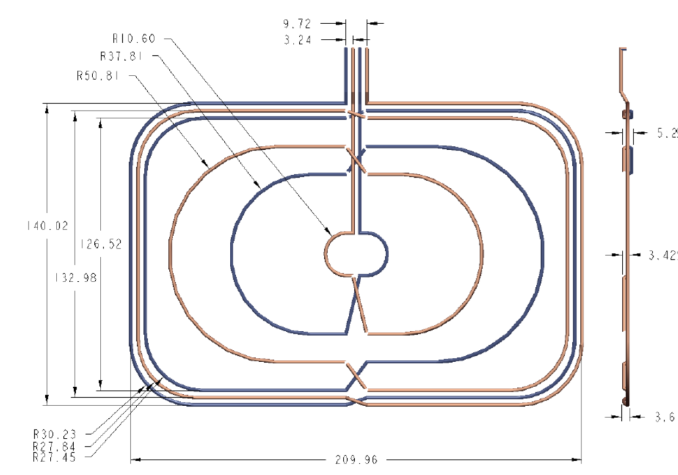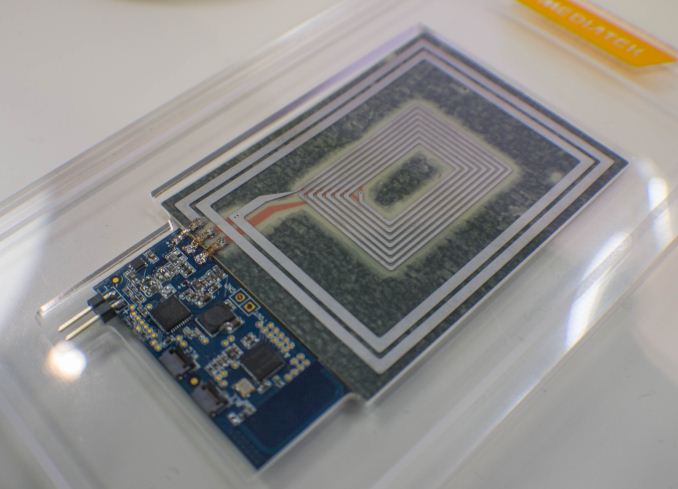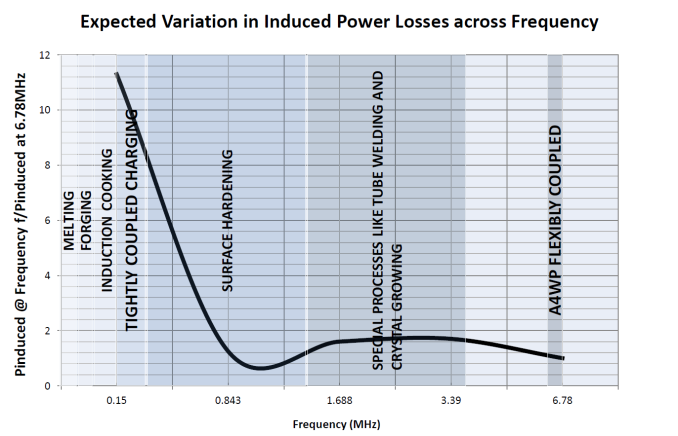The State of Wireless Charging Standards in Mobile
by Andrei Frumusanu on April 2, 2015 8:00 AM ESTRezence Resonance Charging
Earlier we saw the distinction between tightly coupled (TC) and loosely coupled (LC) induction charging systems. While A4WP’s Rezence system is called a magnetic resonance charging system, the basic principle is still based on magnetic induction. The critical difference between Qi and Powermat standards is that it is a Rezence is based on a loosely coupled coil system.
Inductive power frequencies and use-cases (Source)
A4WP systems work on a much higher frequency compared to tightly coupled systems such as defined by PMA and WPC. Rezence’s operating frequency is defined on a strict 6.78MHz (±15kHz) band compared to the 110-357kHz range that Qi and Powermat operate in.
Instead of a tight coil on the transmitter and receivers, we see the usage of a specifically shaped resonator designs. An A4WP transmitter has typically larger footprint than Qi or Powermat designs, with various classes of designs available depending on power requirement. Currently the widely adopted one is the Class 3 transmitter which has a size of 204x146mm and meant for smartphone device use-cases.


A4WP Class 3 spiral type 235-135 power transmit resonator (Source 1, Source 2)
The class system allows A4WP for a variety of size power transmitter unit (PTUs) and power receiving unit (PRUs) resonator coil systems depending on the number of devices and power you are targeting to charge. The class 3 PTU supports up to 16W transmit power.
| PTU Class | Maximum transmission in power |
Minimum PRU Support |
| Class 1 | TBD | >1 x Category 1 |
| Class 2 | 10W | 1 x Category 1, 2, or 3 |
| Class 3 | 16W | 2 x Category 1,2, or 3, or 1 x Category 4 |
| Class 4 | 22W | 3 x Category 1, 2, or 3, or 1 x Category 4 |
| Class 5 | TBD | TDB |
| PRU Category | Maximum reception out power |
Example Applcations |
| Category 1 | TBD | BT headset |
| Category 2 | 3.5W | Feature Phone |
| Category 3 | 6.5W | Smart Phone |
| Category 4 | TBD | Tablet |
| Category 5 | TBD | Laptop |
The current PRU categories are mainly defined for feature phone and smartphone devices with output powers of respectively 3.5 and 6.5W. We should be seeing class 3 devices as the most prevalent category implemented in smartphones in the near future. A class 3 PTU can charge at least two class 3 PRUs at full power, which should be sufficient for most use-cases.
A4WP WPT multi-device charging architecture (Source)
As mentioned before, the LC design of the Rezence charger allows for multiple receivers for a single transmitter, enabling a "star network" of PRUs for each PTU.
While Qi and Powermat respectively use either modulation on the power signal and RFID for communication between the transmitter ans receiver devices, Rezence work with a Bluetooth Low Energy (BLE) connection between all the different actors. There is no device pairing involved as communication is done over GATT (Generic Attribute Profile), a BLE feature.
At MWC2015 multiple vendors were demonstrating their A4WP implementations and chargers, and it was much more impressive to see them in action compared to the TC systems such as Qi and Powermat. Mediatek had a vertically standing Rezence charger which was demonstrated on a Galaxy S4 with custom backplate integrating Mediatek's tri-standard charging solution and powering the device via the dedicated power pins.
Practically, Rezence also seems to be the better solution as one doesn't have to deal with alignment of the device on the charging surface. Charging surfaces can vary in size and have an advantage of reduced complexity as it still remains a single resonator coil, where as Qi requires multiple overlapped coils to achieve the same effect and Powermat doesn't allow such flexibility in the first place.
Closing Thoughts
Having shed a bit more light on the difference and characteristics of the three main charging standard today, the question is on how the future of wireless charging will look. There is an undisputable battle of politics going on between the different standards associations, with each wanting to have their say and their own solutions to the wireless power transfer problem. Though right now the odd man out in all of this is the PMA, as it's hard to argue that Powermat brings any tangible advantages over Qi, not to mention it's a much less widespread standard.
Rezence from the A4WP on the other hand seems to be promising. The A4WP sees tightly coupled systems as first-generation technology that will in the future be replaced by loosely coupled charging implementations such as Rezence. I don't think the lesser charging efficiency will be something that people will mind as the practicality improvements clearly outweigh the disadvantages. The PMA-A4WP merger is seen as a technology swap as the A4WP gains access to a tightly coupled standard and the PMA gets access to a loosely coupled standard.
Meanwhile the WPC is working on its own resonance based loosely coupled system to compete with Rezence, but it's still in the development and we don't yet have much information on it.

MediaTek's tri-standard charging solution demonstration board
IC designers are going forward with tri-standard compatible solutions for wireless charging and that's what I envison will be the the aim for most device manufacturers who will want to include wireless charging into their products. This solves the device compatibility issue, but doesn't solve the problem completely as not all devices will be able to adopt it due to differing form factors. Rezence here again offers the best offering for form factor diversity, power transfer and charger interoperability. Though with the number of factions involved in this battle, it's not necessarily a given that this will be a battle won by technology as opposed to politics.
Ultimately the wireless charging ecosystem has changed a lot over the last few years, and things could again change drastically over the next few years, so nobody knows for sure in which direction the market will shift. We'll be sure to keep an eye on WPT in the future and cover any emerging news on the topic.












90 Comments
View All Comments
Dorek - Thursday, April 2, 2015 - link
As far as I know, the Lumia 830 was the first device to ship with combination Qi/PMA charging (AT&T version only, I think). Came out long before the Galaxy S6.Also, wireless charging is great. I love it. When my girlfriend and I stumble in to our bedroom in the dark, I plop my phone on my nightstand, she spends 20 sleepy seconds in the dark trying to plug micro-USB in to hers.
phantmz - Friday, April 3, 2015 - link
Sounds like most of the people complaining are using the cheap one coil chargers. Pay a little more and get the three coil chargers, they charge much faster and do not cause your phone to heat up. also they are picky where you place your phone.Thermalzeal - Friday, April 3, 2015 - link
Great Article! I'm a huge fan of Qi as I had a Lumia 920 when it came out, and was quite disappointed when ATT (PMA) screwed Microsoft out of offering it on their other phones. On my Lumia 1020 Wireless charging cases are being sold for $150+!!!! What a rip. In terms of usage, it's night and day having several charging pads located around my home. I even have a really cool Panasonic one that auto aligns the coils for precise transmission and it charges faster than the current MicroUSB Nokia charger. There are quite a few products out there that hack Qi into your microUSB but I'm glad that Samsung is taking a stance with the Galaxy 6, and I'm hopeful that Microsoft will do the same with it's upcoming flagship device. I find it quite funny that Apple is far behind in this context, but of course there are some cable revenue streams that they may be clutching on to.sandy105 - Friday, April 3, 2015 - link
I would not want to lose the fast charging capability on phones specially since sometimes its necessary to use while charging (calls,chats). Wireless charging is definitely slower .. keeping the phone on the mat rather than near you with a cable attached of course seems a problem .For tablets , it might make more sense .but if restaurants , coffee shops all start adopting wireless charging stations , then yes i would want that capability in my next phone.
dawheat - Sunday, April 5, 2015 - link
I think folks are being a bit short sighted. If wireless charging can become ubiquitous, it would be a great change. Running low? Top off at Starbucks or local cafe while drinking coffee. Top off at an airport. Never need to carry your cable or worry about adapters when travelling internationally. Have it built into cars.Peichen - Monday, April 6, 2015 - link
Wireless charging is stupid as it stands. Slower than wire and you cannot transfer file at the same time. It will come one day but that requires multiple integrations.Valis - Tuesday, April 14, 2015 - link
Doesn't matter, I'll never get a mobile without removable battery, anyway. I'm not into throw away products that costs $500 or more.Domac30 - Sunday, May 24, 2015 - link
I don't know much about harmfulness or minuses of wireless chargers, but I am very happy to use one of it. The price makes it accessible to all.For example, this one:
http://www.chargersmarket.co.uk/wireless-chargers/...
vaibhav24 - Thursday, April 11, 2019 - link
Wireless Phone Chargers Market Analysis - http://bit.ly/2Z1SW9ODreamann - Friday, May 24, 2019 - link
very good article, let me know more about the differences and characteristics of the three main charging standards. I think the wireless charging ecosystem may change again in the next few years.<a href="https://www.jotrin.com">electronic distributors</a>